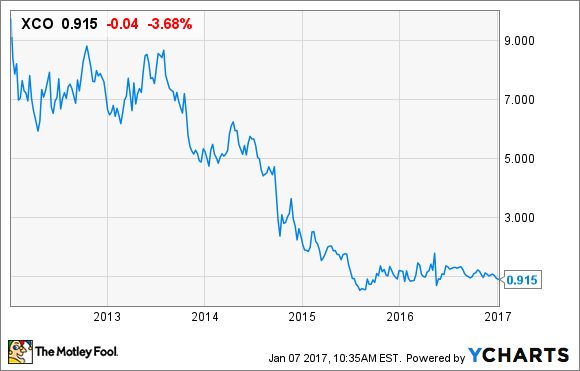Note: This article was originally published May 15, 2015 and updated January 7, 2017.
When we think of penny stocks, our minds drift off to dreams of literally paying pennies for a stock that is eventually worth several dollars. However, more often than not a stock trading for pennies is nothing more than a shell that typically goes to zero. It is why investors should avoid true penny stocks at all costs. However, investors do still have some "penny stock" like options if they are willing to do some dumpster diving.

Image source: Getty Images.
What are penny stocks?
A penny stock, according to the Securities and Exchange Commission, is any stock that trades under $5 per share. Further, these stocks are often not traded on a national exchange such as the NYSE and tend to have ultra-low market capitalizations of less than $200 million. It is the lack of oversight and tiny market caps that often allow scammers to manipulate penny stocks and make money off of your dime.
That is why investors need first to look past the stock price and instead consider the underlying business by making sure the company has viable operations and real prospects to create wealth. Otherwise, an investor runs the risk of buying a ticker that someone else can manipulate for their own gain. With that in mind, it is a good general rule of thumb to avoid stocks that don't trade on national exchanges and have market caps below $200 million -- because these stocks are much more susceptible to manipulation.
That caveat aside, there will always be a draw to invest in stocks with "penny stock" prices as we dream of turning those pennies into dollars. However, should an investor choose to speculate in that way, it should at least be intelligent speculation in a company whose stock has been beaten down, but has a fair chance at a rebound. Further, an investor should not speculate with money that they cannot afford to lose.
For those looking for an intelligent place to speculate, the energy sector is a good place to start because it has several companies trading at "penny stock" prices. A concoction of crashing oil prices mixed with debt decimated many of these stocks. Below, I have selected five severely beaten down energy stocks with low single-digit stock prices that could rally sharply if oil prices pick up over the next year. However, a warning: While these beaten-down energy "penny stocks" could soar, each comes with an extra helping of risk that could obliterate the investment. Buyer beware.

Image source: Getty Images.
Image source: Getty Images.
1. EXCO Resources (NYSE: XCO)
EXCO Resources stock has taken a major hit from plunging natural gas and oil prices over the past few years:
That said, the real weight causing EXCO Resources' collapse is the fact that its debt level is unsustainable at lower commodity prices. To that end, the driller is working to reduce its debt level and entered into several debt exchanges, which cut its total outstanding borrowings and extended its maturities. While it still has more work to do, EXCO Resources' stock could reverse course and head higher if we get a meaningful rally in the oil price.
2. Chesapeake Energy (CHK +0.00%)
If there's one recurring theme on this list, it is that falling oil prices crushed the stock price of energy companies that had too much debt. That is certainly the case at Chesapeake Energy, which saw its stock price tumble 70% over the last three years. The culprit here is the company's massive debt, which pushed it near the brink of bankruptcy:
CHK Financial Debt (Quarterly) data by Charts.
However, Chesapeake has worked hard to solve this daunting problem with debt exchanges and asset sales. If it can continue to reduce and extend its debt successfully, and commodity prices rebound sharply, then this stock could rocket higher.
3. Seadrill (SDRL +0.00%)
Seadrill is a bit of an oddity on this list because it's the only company that doesn't produce oil and gas. Instead, it makes money by leasing offshore drilling rigs to exploration and production companies. The problem with this is that oil companies have significantly pulled back investments in offshore development. This shift caused a steep drop in the dayrates that companies like Seadrill can charge for leasing these rigs, which has reduced the value of its rigs. This decline is worrisome because Seadrill has a fragile balance sheet. However, if oil and gas activity improves, it should improve Seadrill's prospects and its low-single-digit stock price.
4. Denbury Resources (DNR +0.00%)
Denbury, much like Chesapeake Energy and EXCO Resources, has too much debt for the current commodity price environment. To rectify the situation Denbury Resources has been following in their footsteps by exchanging and buying back debt as well as selling assets to lower its outstanding borrowings. These initiatives are helping put the company in a position to wait things out until oil prices rebound. However, that rebound is the key because it will remove a lot of the remaining pressure that's currently holding down Denbury Resources' stock.

Image source: Getty Images.
5. Vanguard Natural Resources (NASDAQ: VNR)
The last name on this list is slightly different because it's an upstream-focused master limited partnership. Because of that Vanguard Natural Resources' business model is built around issuing debt and equity to fund acquisitions to grow its production. That model worked just fine when oil was triple digits, but it is a huge weight now that oil is trading at half of that price. Because of this new market environment, Vanguard Natural Resources is at cross roads. It needs to address its debt, especially the bank debt, as well as determine a new path forward given the troubles with the upstream MLP business model in a low commodity price environment. Unfortunately, the company is running out of time to address its financial problems and could end up filing for bankruptcy if it does not find a solution that puts it back on solid financial footing.
Investor takeaway
There's one key theme among these energy companies: each has too much debt, which upended operations once commodity prices tumbled. However, all five are in the process of fixing their balance sheets. That puts them in a position to potentially thrive if oil and gas prices improve. That said, if prices do not improve in time all five could end up being worthless.
Oil prices per barrel differ depending on type and location, which can mean a lot to oil stocks.








